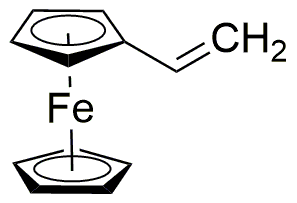Vinylferrocene is widely utilized in research focused on:
- Organic Synthesis: It serves as a versatile building block in the synthesis of various organic compounds, allowing chemists to create complex molecules efficiently.
- Material Science: Used in developing advanced materials, vinylferrocene contributes to the creation of conductive polymers and nanocomposites, enhancing their electrical properties.
- Catalysis: This compound acts as a catalyst in various chemical reactions, improving reaction rates and selectivity, which is particularly beneficial in industrial processes.
- Electrochemistry: Its unique properties make it valuable in electrochemical applications, such as sensors and batteries, where it can enhance performance and stability.
- Biomedical Research: Vinylferrocene is being explored for its potential in drug delivery systems and as an anti-cancer agent, offering innovative solutions in medical applications.
General Information
Properties
Safety and Regulations
Applications
Vinylferrocene is widely utilized in research focused on:
- Organic Synthesis: It serves as a versatile building block in the synthesis of various organic compounds, allowing chemists to create complex molecules efficiently.
- Material Science: Used in developing advanced materials, vinylferrocene contributes to the creation of conductive polymers and nanocomposites, enhancing their electrical properties.
- Catalysis: This compound acts as a catalyst in various chemical reactions, improving reaction rates and selectivity, which is particularly beneficial in industrial processes.
- Electrochemistry: Its unique properties make it valuable in electrochemical applications, such as sensors and batteries, where it can enhance performance and stability.
- Biomedical Research: Vinylferrocene is being explored for its potential in drug delivery systems and as an anti-cancer agent, offering innovative solutions in medical applications.
Documents
Safety Data Sheets (SDS)
The SDS provides comprehensive safety information on handling, storage, and disposal of the product.
Product Specification (PS)
The PS provides a comprehensive breakdown of the product’s properties, including chemical composition, physical state, purity, and storage requirements. It also details acceptable quality ranges and the product's intended applications.
Certificates of Analysis (COA)
Search for Certificates of Analysis (COA) by entering the products Lot Number. Lot and Batch Numbers can be found on a product’s label following the words ‘Lot’ or ‘Batch’.
Numéro de catalogue
Numéro de lot/série
Certificates Of Origin (COO)
This COO confirms the country where the product was manufactured, and also details the materials and components used in it and whether it is derived from natural, synthetic, or other specific sources. This certificate may be required for customs, trade, and regulatory compliance.
Numéro de catalogue
Numéro de lot/série
Safety Data Sheets (SDS)
The SDS provides comprehensive safety information on handling, storage, and disposal of the product.
DownloadProduct Specification (PS)
The PS provides a comprehensive breakdown of the product’s properties, including chemical composition, physical state, purity, and storage requirements. It also details acceptable quality ranges and the product's intended applications.
DownloadCertificates of Analysis (COA)
Search for Certificates of Analysis (COA) by entering the products Lot Number. Lot and Batch Numbers can be found on a product’s label following the words ‘Lot’ or ‘Batch’.
Numéro de catalogue
Numéro de lot/série
Certificates Of Origin (COO)
This COO confirms the country where the product was manufactured, and also details the materials and components used in it and whether it is derived from natural, synthetic, or other specific sources. This certificate may be required for customs, trade, and regulatory compliance.


